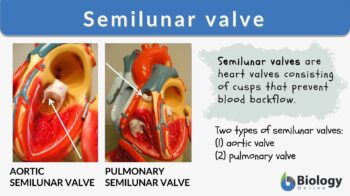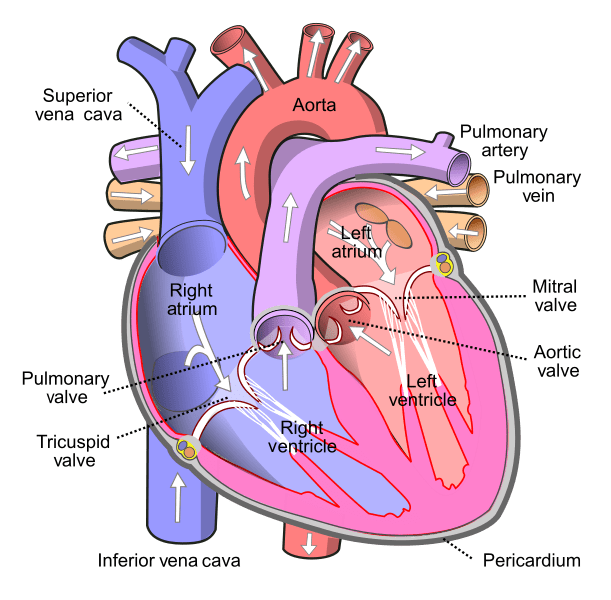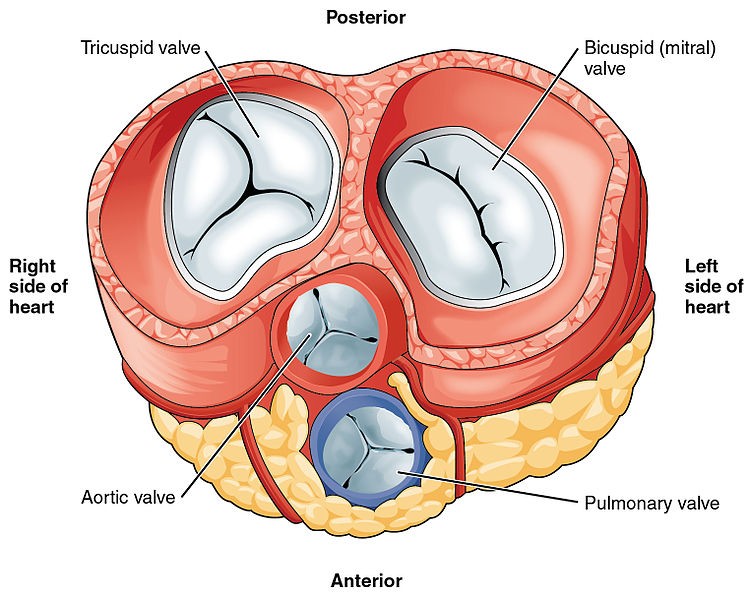
Semilunar valven., plural: semilunar valves[ˌsɛmɪˈluːnə vælv]Definition: heart valve at the base of the aorta and the pulmonary artery, preventing backflow. Image source: Modified by Maria Victoria Gonzaga of Biology Online, from the works of Rob Swatski, CC BY-SA 3.0
Table of Contents
The human heart structure consists of heart chambers (2 atria and 2 ventricles) that differ functionally from each other. Each chamber of these 4 chambers of the heart has a distinct role in blood circulation. The atria take blood from all parts of the body through the superior vena cava and the inferior vena cava, then, the blood is pumped to the lungs from the ventricles. Different parts of the heart contain valves that control the direction of movement of the blood inside the heart. Heart valves allow the blood to move in one direction within the heart while preventing the blood from returning back. So, what are semilunar valves?
Semilunar Valve Definition
The heart of a mammal contains four valves:
- The two atrioventricular valves (AV valves) separate the two atria and the two ventricles. They prevent the blood from returning back to the atria from the ventricles. The two types: bicuspid (mitral) and tricuspid valves.
- The two semilunar valves (SL valves) are located in the arteries allowing the blood movement from the heart to prevent it from returning back to the ventricles during systole. There are two semilunar valves: the aortic semilunar valve that is defined as the valve that protects the point of attachment between the aorta and the left ventricle in the heart and the pulmonary semilunar valve that is defined as the valve located between the pulmonary artery and the right ventricle of the heart. The ventricles are filled with blood only when the semilunar valves are closed.
When valves close, they produce sounds termed heartbeats. There are two distinct sounds heard during a heartbeat; the first sound results from the closure of tricuspid and bicuspid AV valves and the second sound occurs when the aortic and pulmonary SL valves close.
Heart sounds result from the movement of the heart muscle and the large blood vessels around it. When the ventricles contract, the valves close due to the backflow of the blood, producing the first heart sound.
The movement of blood within elastic large vessels (such as the aorta and the pulmonary artery), together with the two ventricles, produces the second sound when the aortic and pulmonary artery close suddenly. When valves open, they do not produce any sound.
The sounds are produced, therefore, only when the valves close, not when they open.

A semilunar valve is the heart valve at the base of the aorta and the pulmonary artery, and consisting of cusps or flaps that prevent the backflow of the blood during systole. Semilunar valves are paired valves of the heart at the bases of the aorta and the pulmonary artery. They, together with atrioventricular valves, form the heart valves in humans. Compare: atrioventricular valves.
Semilunar Valve Structure
The semilunar valves of the heart are made up of flaps or leaflets. The margins of leaflets are connected to the arterial wall in a manner that looks like a half-moon that’s why they are described as “semilunar“. Each leaflet of the aortic and semilunar valves has a core of fibrous tissues and lined by an endothelial tissue with a layer of elastin. Therefore, it is known as the backbone and represented by a collagen layer, which makes it looser.
Semilunar valves are formed of connective tissues. They are located at the end of the pulmonary artery and the aorta at their intersection with the left and right ventricles. They protect the point of attachment of the pulmonary artery and aorta with the ventricles, thus, preventing the blood to flow in the wrong direction. As a result of their fusion, a small part of the arterial wall is considered a ventricular structure.

Semilunar valves of humans
The aortic valve, as well as the pulmonary valve, consists of three cusps. The cusps of the valves of the heart are covered by endocardium foldings. The cusps of semilunar valves are thinner than the leaflets of the atrioventricular valve; however, their structure is similar except that they do not have chordae tendineae. The aortic valve permits the movement of the blood in one direction from the left ventricle into arteries. Therefore, when the left semilunar valve is closed, the blood cannot go back into the ventricle. The pulmonary vessel is found between the right ventricle and the pulmonary artery. Therefore, it is sometimes called the right semilunar valve. As the aortic valve, the pulmonary valve prevents the backflow of blood into the ventricle. The closure of the two semilunar valves produces the second heart sound.
Semilunar valves of other animals
There are slight differences between the shape of cusps and the structure of semilunar valves between humans and other animals. For example, the size of the noncoronary cusp in swine is smaller than the other cusps; in humans, the size of three cusps is uniform. The sheep’s cusps of the aortic valve are thinner than human cusps. Additionally, the muscles supporting the valves are much less in humans when compared to the other animals. The aortic valve in humans is wider in diameter than the other animals. A membranous septum between the aortic and mitral valves varies in length among different species and it is absent in sheep.

Semilunar Valve vs. Atrioventricular Valve
The atrioventricular valves (the mitral and tricuspid valves) separate the two atria and ventricles. They prevent the backflow of blood from ventricles to atria. On the other hand, semilunar valves (aortic and pulmonary valves) separate ventricles and large arteries such as the aorta and pulmonary artery preventing the backflow of the blood from arteries to ventricles. Atrioventricular valves are composed of leaflets but semilunar valves are made up of cusps. Atrioventricular valves are structurally supported by a specialized system while semilunar valves are self-supported due to their distinct structure and location inside arteries.
Atrioventricular valves are attached by the chordae tendineae to the walls of the ventricles. This attachment prevents the inverting of valves. Opening and closure of the valve are entirely affected by the pressure caused by the flow of blood when the muscles of the heart contract. The mitral valve is located on the left side permitting the passage of blood from the left atrium to the left ventricle; it is made up of two leaflets, the aortic and the posterior leaflet. Whereas the tricuspid valve consists of three leaflets: (1) the anterior leaflet, (2) the posterior leaflet, and (3) the septal leaflet. The tricuspid valve is located on the right side of the heart allowing the flow of blood from the right atrium to the right ventricle.
Semilunar valves are not attached to the walls of arteries by chordae tendineae. Instead, they are embedded at the end of the aorta and pulmonary artery. The aortic valve separates the left ventricle and the aorta. It is made up of three cusps: the right coronary cusp, the left coronary cusp, and the non-coronary cusp. The aortic valve opens when the pressure in the left ventricle is greater than that of aortic blood. However, what causes the aortic semilunar valve to close? When the pressure decreases in the left ventricle, the aortic valve closes as a result of ventricular relaxation preventing the backflow of the blood to the left ventricle. The pulmonary valve is located at the right side of the heart, it forms a channel between the right ventricle and the pulmonary artery.
Semilunar Valve Function
During systole, the myocardium contracts moving the cusps of the semilunar valve to the outside. As the heart muscles relax, the pressure on the cusps decreases so they close again. Therefore, the functions of semilunar valves are to allow the flow of blood in one direction to the major arteries carrying the blood to distant regions of the body and to prevent the backflow of the blood from large vessels such as the aorta and pulmonary artery to ventricles in the heart.
The pulmonary semilunar valve function is to open as a result of ventricular contraction allowing the blood to flow in one direction to the aorta and pulmonary arteries. On the contrary, when ventricles relax, semilunar valves close since the pressure decreases produce the second heart sound (dub) P2.
The aortic valve is found at the point of attachment of the aorta and the ventricle. The aortic semilunar valve function is to open as a result of ventricular contraction allowing the blood to flow in one direction from the ventricle to the aorta. When the muscles of the ventricle relax, the pressure decreases, and consequently, the aortic valve closes producing the second sound (dub) A2. The aortic valve is located at the center of the heart in the area between the tricuspid and mitral valves. Consequently, it is known as the centerpiece in the heart and therefore considered as the most important valve in the heart considering the physiological function of the heart.
READ: The Human Physiology: Circulation and Heart Anatomy Tutorial
SEMILUNAR VALVES IN CARDIAC CYCLE:
HEART SOUNDS AND MURMURS:
Semilunar Valve Dysfunction
Valve diseases result in the death of many individuals annually. Valve diseases are usually characterized by either failure of proper valve opening or failure of proper valve closure, it might be due to an obstruction of blood flow, stenosis (valve narrowing), defect in valve closure, or regurgitation (valve allowing the backflow of the blood).
A valve dysfunction is progressive and can finally lead to ventricular compression. The most common form of valve disease is stenosis where the valve is narrow as a result of its thickening and this condition is usually identified as angina, heart failure, and syncope. It occurs during systole when the valve cannot open properly, and so the ventricle contracts harder to deliver the blood to the lungs and other parts of the body.
Valve dysfunctions can be diagnosed clinically and by echocardiography, which is used to identify the progression and severity of the disease. Most valve dysfunction diseases result from genetic malformation. Valvular diseases are usually treated by surgical repair or replacement of valves and sometimes may require treatment with antibiotics such as in the case of infective endocarditis.
Regurgitation refers to a defect in the valve that allows the flow of blood in the wrong direction. This defect may affect any valve, such as the pulmonary, aortic, mitral, and tricuspid insufficiencies. As regurgitation, stenosis may affect any valve.
Infective endocarditis may lead to inflammation of one of the valves where bacteria tend to infect damaged valves. Another form of endocarditis that affects undamaged valves is nonbacterial thrombolytic endocarditis.
Valve dysfunction may be congenital (for example, pulmonary regurgitation) or acquired due to other conditions such as hypertension, infective endocarditis, and disorders of connective tissues. Clinical manifestations of valve dysfunction depend on the type and severity of the disease as well as the affected valve. For example, a valvular disease resulting from bacterial infective endocarditis may cause fever whereas aortic regurgitation or stenosis may cause breathlessness. Complications of valve dysfunction may include embolism due to unregulated blood flow, which will lead to heart failure.
The most common semilunar valve dysfunction is a congenital defect of the heart known as the bicuspid aortic valve dysfunction. It is where the aorta is developed consisting of two cusps instead of three cusps due to the fusion of two cusps during the development of the heart in embryonic stages. This condition is usually subclinical until the development of calcific aortic stenosis within about ten or more years.
Another semilunar dysfunction is pulmonary atresia where the pulmonary valve is completely closed.
The defective semilunar valve can either be repaired or replaced. The repair of a semilunar valve means the reconstruction of its shape and function. Valve repair is often employed for the treatment of regurgitation or to a lesser extent, for the treatment of stenosis. Valve replacement is done by the replacement of the defected valve with a prosthetic or a native valve. Artificial heart valves come in two forms, either mechanical or tissue valves.
Mechanical valves are preferred to young individuals since they last longer than tissue valves. Moreover, they increase the risk of blood clot formation which might lead to an embolism therefore, chronic use of anticoagulants is associated with this type of artificial valve. Mechanical valves are made of metals and they are not similar to normal valves.
Tissue valves are made up of animal pericardial or valve tissues. Animal tissue artificial valves resemble the normal heart valves since they are composed of leaflets forming cusps.
Try to answer the quiz below to check what you have learned so far about semilunar valves.
References
- Barrickman, N., Bell, K., & Cowan, C. (n.d.). Chapter 14: Cardiovascular system. Retrieved March 23, 2021, from https://slcc.pressbooks.pub/humanbiology/chapter/chapter-xx-cardiovascular-system/
- Bateman, M. G., Quill, J. L., Hill, A. J., & Iaizzo, P. A. (2013). The anatomy and function of the semilunar valves. In Heart Valves (pp. 27-43). Springer, Boston, MA.
- Chiras, D. D. (2013). Human biology. Jones & Bartlett Publishers.
- Hinton, R. B., & Yutzey, K. E. (2011). Heart valve structure and function in development and disease. Annual review of physiology, 73, 29-46.
- Human cardiovascular system – Origin and development. (n.d.). Retrieved March 23, 2021, from https://www.britannica.com/science/human-cardiovascular-system/Origin-and-development#ref84801
- Juan Fernando Biguria, M. (2020, December 05). Pulmonic Valve anatomy. Retrieved March 23, 2021, from https://emedicine.medscape.com/article/1923144-overview#showall
- Libretexts. (2020, August 14). 17.2C: Operation of semilunar valves. Retrieved March 23, 2021, from https://med.libretexts.org/Bookshelves/Anatomy_and_Physiology/Book%3A_Anatomy_and_Physiology_(Boundless)/17%3A_Cardiovascular_System%3A_The_Heart/17.2%3A_Circulation_and_Heart_Valves/17.2C%3A_Operation_of_Semilunar_Valves
©BiologyOnline.com. Content provided and moderated by Biology Online Editors.


